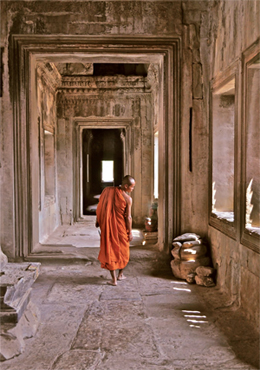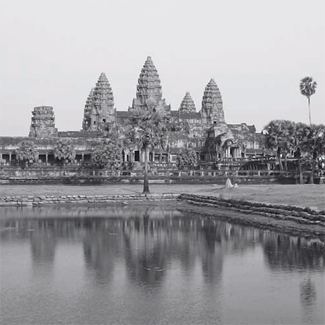NO MATTER HOW MANY TIMES KEITH HOCKTON VISITS THE SPECTACULAR TEMPLE COMPLEX OF ANGKOR, HE IS NEVER LESS AMAZED BY THE SHEER FEAT OF HUMAN ENDEAVOUR, AND FINDS HIMSELF CONSTANTLY RE-ENCHANTED WITH THIS JEWEL IN CAMBODIA’S CROWN.
Cambodia has an exciting edginess to it, similar to that that of exploring an undiscovered country or, if you are a diver, to discovering pirate treasure in a wreck that no one else has found. It’s constantly changing too, for the better. Although there is that sense of discovery, of walking where no man has walked before, there is also a sense of comfort, and it’s the people of Cambodia that ultimately make you feel welcome, as though you are coming home.
A Western Champion
 In 1863 Cambodia, under the King Norodom, became a protectorate of France, and quickly went about embracing everything that France had to offer, including coffee, pastries, and fresh baguettes. Henri Mouhot, a French naturalist and explorer, had ventured into Angkor three years earlier and, over a period of three weeks, made detailed observations of Angkor Wat. These observations were later incorporated into “Travels in Siam, Cambodia and Laos” which was published posthumously after his death in 1861. He’s often credited with discovering Angkor, but, in truth, Angkor was never lost. The location of Angkor Wat and the plethora of sites in and around the 400km that make up Angkor had always been known to the Khmers, and had in fact been visited by Westeners since the 16th century.
In 1863 Cambodia, under the King Norodom, became a protectorate of France, and quickly went about embracing everything that France had to offer, including coffee, pastries, and fresh baguettes. Henri Mouhot, a French naturalist and explorer, had ventured into Angkor three years earlier and, over a period of three weeks, made detailed observations of Angkor Wat. These observations were later incorporated into “Travels in Siam, Cambodia and Laos” which was published posthumously after his death in 1861. He’s often credited with discovering Angkor, but, in truth, Angkor was never lost. The location of Angkor Wat and the plethora of sites in and around the 400km that make up Angkor had always been known to the Khmers, and had in fact been visited by Westeners since the 16th century.
Mouhot did, however, popularise Angkor in the West, and thankfully so! During the time, it was the tendency in the West to ascribe the origin of civilisation to the Middle East, so perhaps none of the previous European visitors wrote as evocatively as Mouhot, who compared Angkor to the pyramids. Mouhot described the Buddha heads at the gateways to Angkor Thom as “four immense heads in the Egyptian style,” and wrote of Angkor:
“One of these temples—a rival to that of Solomon, and erected by some ancient Michael Angelo, might take an honourable place beside our most beautiful buildings. It is grander than anything left to us by Greece or Rome and presents a sad contrast to the state of barbarism in which the nation is now plunged.”
The Original “Wow Factor”
The main palace of Angkor Wat lies just 5km north of Siem Reap and a shorter distance from the previous capital, which was at Baphuon. The ride from Siem Reap is a leisurely one, as the roads are tree-lined and un-crowded. Cambodians are genuinely friendly, polite, and happy and it’s hard to imagine, as you sit and watch the children and adults waving and smiling at you from their villages, the horror that they have lived through in our age (Khmer Rouge 1975-79) without it seemingly affecting them. The fact that 50% of the population is younger than 22 years of age, and have no memory of anything before 1989 has something to do with it.
Angkor Wat itself is breath-takingly beautiful, and no matter how many times you visit the site, it’s beauty never fades. The grandeur and harmony of the architecture, its extensive bas-reliefs, and numerous guardian spirits that adorn almost of its walls are, quite simply, amazing. The “wow factor”, if not invented for Angkor Wat, should have been.
An Architectural Jewel
 A 30m apron of grassed open ground and a moat 190m wide surround the impressive tree-lined outer wall of the complex. The moat itself is serene, and there is something magical about it. Naked children can be seen swimming in the shallows and there is simplicity and innocence about the scene that takes one back to one’s own childhood and carefree days.
A 30m apron of grassed open ground and a moat 190m wide surround the impressive tree-lined outer wall of the complex. The moat itself is serene, and there is something magical about it. Naked children can be seen swimming in the shallows and there is simplicity and innocence about the scene that takes one back to one’s own childhood and carefree days.
Access to the temple complex is by an earth bank to the east and a sandstone causeway to the west; the latter and main entrance is thought to be a later edition, possibly replacing a wooden bridge. Under the southern tower is a statue of Vishnu known as Ta Reach, which archaeologists think may originally have occupied the temple’s central shrine. When, how, and why it was moved is not known.
Galleries run between the towers and as far as two further entrances on either side of the gopura often referred to as “elephant gates”, as they are large enough to admit those animals. The ceiling between the pillars is decorated with lotus rosettes; the west face of the wall with dancing figures; and the east face of the wall with blustered windows, dancing male figures on prancing animals, and devatas, including (south of the entrance) the only one in the temple to be showing her teeth.
The impressive outer wall encloses a space of 820,000 square metres. Inside this wall lies the temple proper and, at one stage, a city, while to the north of the temple lies the royal palace. None of the city exists today as it was built of perishable materials, but when you look at the site and realise that, in the 16th century, over a million souls once lived here (London at the same time had a population of 200,000), it is quite astounding.
The central temple of Angkor Wat is everything that you expect it to be. That 20% of the devatas are in poor condition, mainly due to natural erosion and the deterioration of the stone, takes nothing away from its beauty. In some curious way the deterioration adds to the attraction, and there is a need to touch the walls and gates as you pass through them, to connect with the structure and the ancient souls that once walked its halls. The collapsed sections of the upper structure in the west façade tell you something of the temples age, and that this incredible temple has survived since the 12th century tells you more about the architects and builders.
Angkor Wat has drawn praise, and continues to do so, for the harmony of its design, which has been compared to the architecture of Ancient Greece and Rome. According to Maurice Glaize, a mid-20th century conservator of Angkor, the temple “attains a classic perfection by the restrained monumentality of its finely balanced elements and the precise arrangement of its proportions. It is a work of power, unity and style.” It is a statement that you cannot but agree with, no matter how many times you visit the site or meander leisurely through its grounds and structures.
This article was written by Keith Hockton for The Expat magazine.
Source: The Expat July 2012
Register on ExpatGoMalaysia and be updated with the latest news, articles, and events.
"ExpatGo welcomes and encourages comments, input, and divergent opinions. However, we kindly request that you use suitable language in your comments, and refrain from any sort of personal attack, hate speech, or disparaging rhetoric. Comments not in line with this are subject to removal from the site. "




















